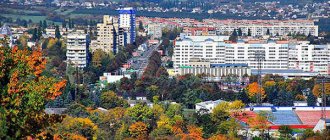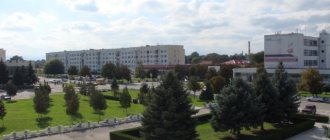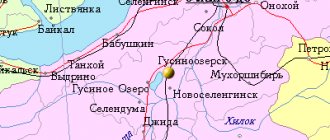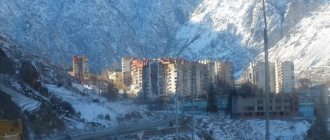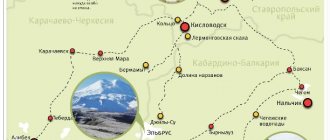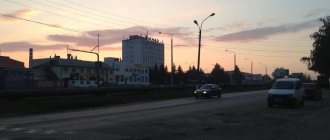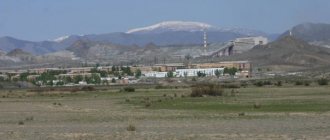May
, a city in Russia, the administrative center of the Maysky district of the Kabardino-Balkarian Republic, within the Pyatigorsk diocese. Located at the foot of the northern slope of the Greater Caucasus, in the Mozdok steppe, on the Terek and Cherek rivers, on the Prokhladny-Vladikavkaz highway, 41 km northeast of Nalchik. Railway station Kotlyarevskaya. Population - 26.8 thousand (2011).
- On the map: Yandex.Map, Google map
Founded in 1819 on the banks of the Terek as a Russian military post Prishib
, because
was located on the edge - a cliff at the bend of the river. Since 1824 - the Prishib fortification, near which there was a Cossack settlement. According to the description of that time, Prishib was “ a small square quadrangle with a deep ditch and a rampart, among which barracks were dug in the ground, and guns peeked out of the embrasures in the corners... The soldiers built several houses and a small apartment for travelers
” [1].
In 1829 it was transformed into the village of Prishibskaya
.
Another component of the future city was the village of Kotlyarevskoye
, 81 versts from Vladikavkaz, in Bolshaya Kabarda, on the Georgian Military Road, on the left bank of the Terek, near the Pogorelodubsky post.
The name, obviously, comes from the name of the landowner, a descendant of the Koshe Ataman of the Black Sea Cossacks, Major General Kotlyarevsky, who was at the helm of the organization of the Black Sea Cossacks. It was planned to settle one hundred families here, and the settlement of military settlers began in 1840 [2]. In 1875, the Kotlyarevskaya station of the Vladikavkaz Railway was built. By 1888, the station village of Kotlyarevsky
, administratively subordinate to the Prishibsky stanitsa board.
The rapid development of the village began with the construction of a brick factory in 1906. Since 1920 - the station village of Prishibsky
.
In 1925 it was renamed Maisky
, in honor of the First of May holiday. Since 1938 - a working village, the center of the Maysky district of the Kabardino-Balkarian Autonomous Soviet Socialist Republic.
In 1959, the village and the village were united into the working village of Maisky
, which received city status in 1965. By the end of the Soviet period, there were factories for X-ray equipment, reinforced concrete products and construction parts, a hemp plant, a woodworking plant, a brewery plant, a calibration plant, and an alcohol and yeast plant.
Statistics
- 1939 - 5.9 thousand people
- 1959 - 12.4 thousand people
- 1970 - 18.6 thousand people
- 1989 - 24.5 thousand people
- 2005 - 27.2 thousand people
Links
Useful
See what “Maisky (Kabardino-Balkaria)” is in other dictionaries:
Kabardino-Balkaria - Kabardino Balkaria. The numbers indicate: 1. Elbrus National Park 2. Kabardino Balkar Nature Reserve Kabardino Balkaria, Kabardino Balkar Republic, in the south of the European part of Russia, borders on Georgia. Included in the North Caucasian... ... Dictionary "Geography of Russia"
KABARDINO-BALKARIA - KABARDINO BALKARIA, Kabardino Balkar Republic, subject of the Russian Federation; in the south of the European part of Russia, bordering on Georgia. Included in the North Caucasus economic region. Pl. 12.5 thousand km2. Population 791.9 thousand people. (1998). The capital of the city ... Russian history
Kabardino-Balkaria — Coordinates: 43°35′ N. w. 43°24′ E. d. / 43.583333° n. w. 43.4° east d. ... Wikipedia
Maysky district (Kabardino-Balkaria) - This term has other meanings, see Maysky district. Maysky district of Kabard. cher. Maiske kedzygue karach. bulk May district Country ... Wikipedia
Alexandrovskaya (Kabardino-Balkaria) - This term has other meanings, see Alexandrovskaya. Stanitsa Alexandrovskaya Country RussiaRussia ... Wikipedia
Prokhladny (Kabardino-Balkaria) - City of Prokhladny Coat of Arms ... Wikipedia
Tersky region (Kabardino-Balkaria) - This term has other meanings, see Tersky region. Tersky region Kabard. cher. Terch kedzygue karach. bulk Terk region Country ... Wikipedia
Kabardino-Balkarian Republic - "KBR" request is redirected here; see also other meanings. Kabardino Balkar Republic K'eberdey Balk'er Republic of K'abarty Malk'ar Republic ... Wikipedia
Kabardino-Balkarian Autonomous Soviet Socialist Republic - Kabardino Balkaria. As part of the RSFSR. On January 16, 1922, the Kabardino Balkar Autonomous Okrug was formed; transformed into the Autonomous Soviet Socialist Republic on December 5, 1936. Area 12.5 thousand km2. Population 614 thousand people (1972 estimate). In K.B. there are 8 districts, 7 cities, 7 villages... ... Great Soviet Encyclopedia
Maysky district of Kabardino-Balkaria - Maysky district Country Russia Status Municipal district ... Wikipedia
Source
Story
As the old-timers of the village say, it used to be called Pavlovka. By the name of Lady Pavlova, who owned this land until 1917.
During the Great Patriotic War, fierce battles took place in the village of Maisky (Pavlovka). The area changed hands twice - in October 1942, March 1943. In October 1941, when the Germans came to Pavlovka, the dark days of occupation dragged on. Residents bravely survived the war.
In 1957, a regional agricultural experimental station was organized with the aim of studying local opportunities for increasing agricultural production and introducing scientific achievements into the practice of collective and state farms in the region. The station had several old livestock buildings and dilapidated dwellings, a small number of outbred cattle, and uncultivated lands. 14 years have passed. The station has grown into a large experimental and elite seed farm. Instead of old, primitive livestock buildings and dilapidated dwellings, houses with amenities, modern mechanized livestock farms, seed storage facilities, a tractor and automobile park, and a solid electric power plant appeared. Based on the Decree of the Presidium of the Supreme Council of the RSFSR dated January 29, 1968, the village of the regional experimental agricultural station in the Belgorod region was renamed into the village. May. In 1971, NIPTIZH was organized, and since 1978 it has become an educational scientific center. The student learning process is closely intertwined with their participation in scientific research. On the basis of the educational research center, the Belgorod Agricultural Institute (Agricultural Institute) was created in 1978, and in February 1994 the Belgorod State Agricultural Academy was created. Its activities are of significant importance not only for the development of the agro-industrial complex of the region, but also of the Central Black Earth region as a whole. The Academy has created a powerful scientific base for conducting research at a high scientific and methodological level. A great contribution to the development of the Academy was made by Doctor of Agricultural Sciences, Professor, Hero of Socialist Labor A.F. Ponomarev.
Attractions
On April 23, 2005, the Metropolitan of Belgorod and Stary Oskol performed a prayer service to consecrate the foundation of the Church of St. Alexis, Metropolitan of Moscow and Wonderworker of All Rus'. On July 8, 2006, the Temple in the village of Maiskoye became operational.
On January 9, 2012, on the day of the 90th anniversary of the twice hero of socialist labor Vasily Gorin, the head of the Belgorod region Evgeny Savchenko unveiled a monument to the outstanding agrarian of the region, who has led the collective farm named after him for 53 years. Frunze. The sculpture by the Moscow author Oleg Kievsky was installed in the village of Maisky, on the site in front of the educational building No. 1 of the Belgorod State Agricultural Academy. In 2011, this educational institution was named after Vasily Gorin.
Source
May
center of the municipal district Maysky district
Population: 26.755 thousand people. (2010) Telephone code: +7 86633 Nearest airport: Nalchik
In the North Caucasus, 41 km from the city of Nalchik, in the interfluve of the Terek and Cherek rivers, the city of Maisky . The city received this name not by chance. According to the ideology of Soviet times, many things, including cities, were given names associated with May Day.
It begins its history in 1819 as a military post “Prishib” (the place where the river hits at a bend). Over time, it expands and represents a small fortification. Continuing to grow, since 1829, the post was renamed the village of Prishibskaya. Almost 50 years later, the Kotlyarevskaya station was built on the Vladikavkaz railway. Over time, a station village appears next to the station, bearing the same name. At the beginning of the 20th century, a brick factory was built in the village, and a decision was made to unite the station and the village. And the resulting settlement will be renamed the village of Maisky.
Since 1965, already having the status of a city, Maisky continues to develop. The population is growing, the food engineering industry is developing. They grow grapes and produce syrups and wines.
Currently, Maysky is the industrial and agricultural center of the Kabardino-Balkarian Republic
One of the city’s attractions is the ancient city of Julat, found during archaeological excavations. Based on excavation materials, the city in the XIII-XIV centuries. took far from the last place in the North Caucasus.
In Maiskoye there is a historical and ethnographic museum of the village of Kotlyarevskaya. In the museum you can trace not only the history of the Turkic Cossacks, learn about their formation, but also how the relationship between the peoples of the North Caucasus was formed.
Not far from the railway station there is the so-called Pushkin Oak. Traveling to Georgia, A.S. Pushkin stayed in the village of Prishibskaya. The oak tree remained a witness to this. Other great people also visited Maisky: M.Yu. Lermontov, A.S. Griboyedov, L.N. Tolstoy. In their works one can find a description of the North Caucasus, namely a city called the village of Prishibskaya. At that time, Russia and Transcaucasia were connected by only one road. And she passed through this city.
Source
Geography
The city is located in the central part of the Maysky district, between the Cherek and Terek rivers. It is located 45 km northeast of the city of Nalchik and 12 km south of the city of Prokhladny.
It borders on the lands of settlements: Kotlyarevskaya in the south, Psykod in the southwest, Novo-Ivanovskoye in the west, Oktyabrskoye in the northwest, Sarskoye in the north, Krasnoarmeyskoye and Dzhulat in the east.
The city is located on the sloping Kabardian Plain, in the flat zone of the republic. The average altitude in the city is 217 meters above sea level. The terrain consists of relatively flat areas without sharp fluctuations in relative heights. To the southeast and southwest of the city there are low-altitude hills with a developed system of gullies.
The hydrographic network in the city is represented by the Cherek, Terek and Demenyuk rivers (flowing through the city center). There are also many artificial reservoirs (quarries) in the city. The area is rich in underground springs and abounds in fresh water resources. The depth of groundwater in the city is only about 2-3 meters.
Located in a semi-arid temperate climate zone ( Dfa
according to the Köppen climate classification)[3]. Summer is hot, and temperatures in July-August often rise above +35°C. Winter is mild with average January temperatures of about +1°C...-3°C... Frosts below -15°C are extremely rare; the city's infrastructure is not designed for such temperatures. The average annual precipitation is about 600 mm. In the period from April to July there are heavy rains with hail; in August, dry winds blowing from the Caspian lowland often reach the city territory.
Mayskoe rural settlement
Belgorod Agricultural Academy
District House of Culture
Production of mineral water "May Crystal"
| Locality | Population | Where? |
| Maysky village | 8022 | |
| village Novaya Derevnya | 198 | |
| Politotdelsky village | 849 |
Total: 9069 people.
Physiographic characteristics
The village of Maisky is located 12 km southwest of Belgorod on the left side of the Moscow-Simferopol international highway. On the territory of the village there is a picturesque pond, separated by a dam, the Makeevsky, Skripensky, Redkodub forests; tracts Kapitanskoe, Dolginkoe. The Mayskoe rural settlement is located in the center of the Belgorod region, has borders with six settlements in the region, as well as the city of Belgorod (in the north).
The Mayskoye rural settlement is located on an area of 6956 hectares. The total population is 9164 people.
Postal indexation
List of streets
Story
As the old-timers of the village say, it used to be called Pavlovka. By the name of Lady Pavlova, who owned this land until 1917.
Authorities
The zemstvo assembly of the Maysky rural settlement includes 12 deputies: Manokhin Alexander Nikolaevich, Korneiko Elena Alexandrovna, Kornienko Pavel Petrovich, Levdik Nikolai Nikolaevich, Litvinov Yuri Nikolaevich, Manokhin Sergey Petrovich, Miroshnichenko Viktor Alexandrovich, Litvin Maxim Vasilievich, Pogorelova Lyudmila Ivanovn, Starodubtseva Olga Alexander Aries , Tsyapka Tamara Nikolaevna, Yakovenko Nikolay Anatolievich.
Population
The total population is 9164 people.
Economy
Currently, existing facilities are being preserved as much as possible, and new ones are being built. The decoration of the village was the new palace of culture. The May Palace of Culture with 600 seats was put into operation in 2005. In 2007, a new swimming pool was put into operation, the length of its five lanes is 25 meters.
To date, design and estimate documentation for the reconstruction of the medical outpatient clinic has been prepared. The overhaul of kindergarten No. 4 is being completed, which will make it possible to solve the problem of providing preschool children for the foreseeable future.
The landscaped areas of the buildings of the Agricultural Academy, residential buildings, the May Gymnasium, the central square of the village and the “Walk of Glory” are pleasing to the eye.
Children's playgrounds, sidewalks, and asphalt roads have been built in local areas; work is underway to lay gas pipelines, power lines and water supply lines.
The administration of the rural settlement carried out comprehensive work on road safety: the location of road signs for the village of Maisky and the village of Politotdelsky was developed, road markings were carried out, and road signs were installed.
Capital construction and reconstruction of the academy's facilities is actively underway. Over the past three years alone, over 127 million rubles have been allocated for capital construction in the village of Maisky, the building of the Faculty of Veterinary Medicine with a veterinary clinic, the educational and exhibition complex “Agrotechnopark” have been commissioned, the surrounding area has been landscaped, a landscape park and arboretum have been laid out, a stable and an equestrian school arena, a training rabbit farm, a student recreation center, and construction of a student dormitory has begun.
A children's playground is equipped: benches, sandboxes, small architectural forms, swings and a wall bars.
How to get there
Suburban bus routes:
Religion
The foundation stone of the temple was consecrated on July 7, 2002. The temple was consecrated by Archbishop John of Belgorod and Stary Oskol on July 16, 2006. Temple page.
The new Orthodox church became a decoration of the village. It is named in honor of St. Alexy, Metropolitan of Moscow and All Rus'. Built according to the architectural canons of the 14th century, its style resembles the temple in Yaroslavl. It is crowned with five domes, four of which are made in the form of multi-colored domes, giving a festive mood and striking with their splendor and originality.
Education
The Academy has a modern material and technical base, including classrooms equipped with computer and audiovisual equipment, educational and scientific laboratories, an information and analytical center, dormitories, a library, a training and production base (workshops for the production and processing of agricultural products), an equestrian school , physiological complex, etc.
The municipal educational institution "May Gymnasium" received the status of an innovative level institution; the functioning of the gymnasium as an innovative educational institution reflects the transition from mass unified education to differentiated education, focused on a specific student. In 2006, the Mayskaya Gymnasium municipal educational institution became the winner of the competition for the best educational institutions in Russia within the framework of the national project “Education”.
Healthcare
Culture
Today, the May Palace of Culture is a center of mass, publicly accessible, democratic leisure activities, allowing people of all ages to realize their interests and hobbies and become involved in culture. Cultural and leisure events, promotions, holidays, festivals, shows, competitions, and concerts are held here. In the building of the May Palace of Culture there is a children's art school and the May Municipal Library, a branch of the Belgorod Central Library.
Attractions
On the territory of the Maysky settlement district there are 2 monuments to fallen soldiers during the Great Patriotic War. The mass grave is located on the southwestern side of the village of Maisky on the Moscow-Simferopol highway. Pupils of the May Gymnasium and students of the Faculty of Agronomy of the Belarusian State Agricultural Academy constantly monitor the condition of the burial. There is an alley leading to the monument. The monument “War with the Machine Gun” was erected on May 9, 1960. It is made of reinforced concrete. Restored on October 1, 1968. The names of the victims are engraved on the marble slabs. 43 people were buried. In 1989, the Eternal Flame was brought to the monument. The “Search” club, which was founded by Liliya Glebovna Sharshanova, united schoolchildren of all ages. The collected material served as the basis for the local history museum, now operating in the May Gymnasium.
On the territory of the village of Maisky there is a picturesque pond divided by a dam, the Makeevsky, Skripensky, Redkodub forests; tracts Kapitanskoe, Dolginkoe. The Mayskoe rural settlement is located in the center of the Belgorod region, has borders with six settlements in the region, as well as the city of Belgorod (in the north). The Mayskoye rural settlement is located on an area of 6956 hectares.
Famous personalities
It was possible to transform the village of Maisky into a successful and prosperous one thanks to the high responsibility of its residents for their small homeland, thanks to high civic activity, participation in the development of democracy and local self-government.
Source
Education
Secondary education
- Gymnasium No. 1 - st. Gagarina, 10/11.
- Secondary school No. 2 - st. Kirova, 227.
- Secondary school No. 3 - st. Labor 48.
- Secondary school No. 5 - st. Gorky, 116.
- Secondary school No. 10 - st. Medvedeva, 10.
- Secondary school No. 14 - st. Komarova, 13 "a".
Preschool education
- Progymnasium No. 13 - st. Gorky, 112.
- Primary school Kindergarten "Rainbow" - st. Engelsa, 63.
- Primary school Kindergarten No. 2 - st. Kirova, 53.
- Primary school Kindergarten "Skazka" - st. May 9, 2.
- Primary school Kindergarten "Kazachok" - st. Kalinina, 94.
- Primary school Kindergarten "Beryozka" - st. Komarova, 13.
- Primary school Kindergarten “Smile” - st. Engelsa 63/2.
- Primary school Kindergarten "Swallow" - st. Lenina, 42.
- Primary school Kindergarten "Romashka" - st. Chekhova, 13.
Other educational centers
- Center for Children's Creativity - st. Oktyabrskaya, 46.
- Children's and youth sports school - st. Sverdlova, 64.
Historical reference
Founded in 1819 on the banks of the Terek as a Russian military post at Prishib. Since 1824, the fortification of Prishib, near which there was a Cossack settlement, was transformed into the village of Prishibskaya in 1829. The name is from Russian, “a cliff near the river at a bend, a bend, where the water hits at the turn.”
In 1875, the Kotlyarevskaya station of the Vladikavkaz Railway was built 3 km south of the village. The name, obviously, comes from the name of the landowner, a descendant of the Koshe Ataman of the Black Sea Cossacks, Major General Kotlyarevsky, who was at the helm of the organization of the Black Sea Cossacks.
In 1888, the station village of Kotlyarevsky grew up, administratively subordinate to the Prishibsky stanitsa government.
Since 1920, the station village of Prishibsky, since 1925 it was called Maysky. This name, common in Soviet times, had an ideological meaning, being a variant of the name Pervomaisky.
Since 1938, the working village of Maisky, the center of the Maysky district of the Kabardino-Balkarian Autonomous Soviet Socialist Republic.
In 1959, the village and the village were united into the working village of Maisky. City since 1965
Not far from the railway station there is a mighty oak tree - this is the only tree that was left to grow when the railway was laid in 1875. According to legend, A.S. rested under this oak tree. Pushkin on the way to Tiflis.
Every year, traditional Pushkin holidays are held near the oak tree. Maichans love these unforgettable encounters with poetry.
Is this true or a fairy tale, But there is no doubt that our glorious Caucasian land was visited by a poet. And, looking at the branchy oak, at the shady roof, You hear the pure voice of Pushkin’s poems... It was Pushkin who gave greatness to that Tree, And as our custom dictates, Bow to him!
Amirkhan Shomakhov, people's poet of Kabardino-Balkaria
Railway station Kotlyarevskaya. It is with her that the appearance and development of Mr. Maisky is connected. Today it continues to play an important role in the economic life of the city and region. The stone station building is a classic example of railway construction from the beginning of the century – and to this day greets and sees off the residents and guests of Mayskoye.
In 1925, at a general meeting of citizens of the village of Prishibskaya and the railway village of Kotlyarevsky, due to the fact that the settlements had merged geographically, this settlement was given the name - the village of Maysky.
The village of Maisky became the center of the region in 1938. Since 1965, the village of Maisky received city status.
The city-forming enterprises of the city were the May Electronic Engineering Plant, whose achievements were known not only in the city, in the republic, but also in the electronics industry and instrument making.
The Electronic Engineering Plant and its design bureau participated in the creation of the Buran reusable spacecraft, for which they were awarded an honorary diploma from the Energia aerospace corporation. For many years the plant was led by A.A. Mamilov. Under his leadership, the plant was the leading enterprise of the region and the Ministry of Electronic Industry
JSC Sevkavrentgen has made and continues to make a great contribution to the production of medical diagnostic equipment. In 2004, JSC Sevkavrentgen was awarded a diploma as a laureate of the competition for the President of the KBR in the field of quality for the production of the X-ray diagnostic complex "X-ray-47". At different times, its former managers N.P. Zhukov had a great influence on the development of OJSC SKRZ. and Vodopyanov L.I. Now it is LLC Sevkavrengen-D and is headed by Ponomarenko R.N.
Nikolai Nikitovich Yevtushenko, Hero of Socialist Labor, Doctor of Agricultural Sciences, WWII participant, and Sergei Mikhailovich Ushanev, Hero of the Soviet Union, holder of many military orders and medals, lived and worked in the city for a long time.
In 2009, the city square was reconstructed.
In 2010, a park was laid out next to the Pushkin oak tree and a children's playground was installed. A modern sports and recreation complex was built and put into operation.
Work is actively underway to formulate and implement city programs in the field of energy saving, reforming housing and communal services, equipping a network of medical institutions and medical and social assistance to the population, in the field of youth policy, and the development of mass participation in physical culture and sports.
Excerpt characterizing Maisky (Kabardino-Balkaria)
“Quant a celui qui a conseille ce camp, le camp de Drissa, [As for the one who advised the Drissa camp,” said Paulucci, while the sovereign, entering the steps and noticing Prince Andrei, peered into an unfamiliar face . – Quant a celui. “Sire,” continued Paulucci desperately, as if unable to restrain himself, “qui a conseille le camp de Drissa, je ne vois pas d’autre alternative que la maison jaune ou le gibet.” [As for the man who recommended the camp at Drisei, sir, in my opinion, there are only two places for him: the yellow house or the gallows.] - Without listening to the end and as if not having heard the words of the Italian, the sir, having learned Bolkonsky, graciously turned to him: “I’m very glad to see you, go to where they gathered and wait for me.” - The Emperor went into the office. Prince Pyotr Mikhailovich Volkonsky, Baron Stein, followed him, and the doors closed behind them. Prince Andrei, using the permission of the sovereign, went with Paulucci, whom he knew back in Turkey, into the living room where the council was meeting. Prince Pyotr Mikhailovich Volkonsky held the position of chief of staff of the sovereign. Volkonsky left the office and, bringing cards into the living room and laying them out on the table, conveyed the questions on which he wanted to hear the opinions of the assembled gentlemen. The fact was that during the night news was received (later turned out to be false) about the movement of the French around the Drissa camp. General Armfeld began to speak first, unexpectedly, in order to avoid the difficulty that had arisen, proposing a completely new, inexplicable position away from the St. Petersburg and Moscow roads, on which, in his opinion, the army should have united and await the enemy. It was clear that this plan had been drawn up by Armfeld long ago and that he now presented it not so much with the aim of answering the proposed questions, which this plan did not answer, but with the aim of taking advantage of the opportunity to express it. This was one of the millions of assumptions that could be made, just as well as others, without having any idea of what character the war would take. Some disputed his opinion, some defended it. The young Colonel Toll, more ardently than others, disputed the opinion of the Swedish general and during the argument took out a covered notebook from his side pocket, which he asked permission to read. In a lengthy note, Toll proposed a different campaign plan, completely contrary to both Armfeld’s plan and Pfuel’s plan. Paulucci, objecting to Tol, proposed a plan for moving forward and attacking, which alone, according to him, could lead us out of the unknown and the trap, as he called the Dris camp, in which we were located. Pfuhl and his translator Wolzogen (his bridge in court relations) remained silent during these disputes. Pfuhl only snorted contemptuously and turned away, showing that he would never stoop to object to the nonsense that he was now hearing. But when Prince Volkonsky, who led the debate, called him to express his opinion, he only said: “Why ask me?” General Armfeld proposed an excellent position with an open rear. Or attack von diesem italienischen Herrn, sehr schon! [this Italian gentleman, very good! (German)] Or retreat. Auch gut. [Also good (German)] Why ask me? - he said. – After all, you yourself know everything better than me. - But when Volkonsky, frowning, said that he was asking his opinion on behalf of the sovereign, Pfuel stood up and, suddenly animated, began to say: “They ruined everything, confused everything, everyone wanted to know better than me, and now they came to me: how to fix it.” ? Nothing to fix. Everything must be carried out exactly according to the principles I have laid out,” he said, banging his bony fingers on the table. – What is the difficulty? Nonsense, Kinder spiel. [children's toys (German)] - He went up to the map and began to speak quickly, pointing his dry finger at the map and proving that no accident could change the expediency of the Dris camp, that everything was foreseen and that if the enemy really goes around, then the enemy must inevitably be destroyed. Paulucci, who did not know German, began asking him in French. Wolzogen came to the aid of his principal, who spoke little French, and began to translate his words, barely keeping up with Pfuel, who quickly proved that everything, everything, not only what happened, but everything that could happen, was all foreseen in his plan, and that if there were now difficulties, then the whole fault was only in the fact that everything was not executed exactly. He laughed ironically incessantly, argued, and finally contemptuously gave up proving, just as a mathematician gives up verifying in various ways the correctness of a problem that has once been proven. Wolzogen replaced him, continuing to express his thoughts in French and occasionally saying to Pfuel: “Nicht wahr, Exellenz?” [Isn't that true, Your Excellency? (German)] Pfuhl, like a heated man in battle hitting his own, angrily shouted at Wolzogen: - Nun ja, was soll denn da noch expliziert werden? [Well, yes, what else is there to interpret? (German)] - Paulucci and Michaud attacked Wolzogen in French in two voices. Armfeld addressed Pfuel in German. Tol explained it in Russian to Prince Volkonsky. Prince Andrei silently listened and observed. Of all these persons, the embittered, decisive and stupidly self-confident Pfuel most excited the participation of Prince Andrei. He alone, of all the people present here, obviously did not want anything for himself, did not harbor enmity towards anyone, but wanted only one thing - to put into action the plan drawn up according to the theory he had developed over years of work. He was funny, unpleasant in his irony, but at the same time he inspired involuntary respect with his boundless devotion to the idea. In addition, in all the speeches of all the speakers, with the exception of Pfuel, there was one common feature that was not present at the military council in 1805 - it was now, although hidden, a panicky fear of the genius of Napoleon, a fear that was expressed in everyone objection. They assumed everything was possible for Napoleon, waited for him from all sides, and with his terrible name they destroyed each other’s assumptions. Only Pfuel, it seemed, considered him, Napoleon, to be the same barbarian as all the opponents of his theory. But, in addition to a feeling of respect, Pful instilled in Prince Andrei a feeling of pity. From the tone with which the courtiers treated him, from what Paulucci allowed himself to say to the emperor, but most importantly from the somewhat desperate expression of Pfuel himself, it was clear that others knew and he himself felt that his fall was close. And, despite his self-confidence and German grumpy irony, he was pitiful with his smoothed hair at the temples and tassels sticking out at the back of his head. Apparently, although he hid it under the guise of irritation and contempt, he was in despair because now the only opportunity to test it through vast experience and prove to the whole world the correctness of his theory eluded him. The debate continued for a long time, and the longer it continued, the more the disputes flared up, reaching the point of shouting and personalities, and the less it was possible to draw any general conclusion from everything that was said. Prince Andrei, listening to this multilingual conversation and these assumptions, plans and refutations and shouts, was only surprised at what they all said. Those thoughts that had long and often occurred to him during his military activities, that there is and cannot be any military science and therefore there cannot be any so-called military genius, now received for him the complete evidence of the truth. “What kind of theory and science could there be in a matter in which the conditions and circumstances are unknown and cannot be determined, in which the strength of the war actors can be even less determined? No one could and cannot know what the position of our and the enemy’s army will be in a day, and no one can know what the strength of this or that detachment will be. Sometimes, when there is no coward in front who will shout: “We are cut off!” - and he will run, and there is a cheerful, brave man in front who will shout: “Hurray! - a detachment of five thousand is worth thirty thousand, as at Shepgraben, and sometimes fifty thousand flee before eight, as at Austerlitz. What kind of science can there be in such a matter, in which, as in any practical matter, nothing can be determined and everything depends on countless conditions, the meaning of which is determined in one minute, about which no one knows when it will come. Armfeld says that our army is cut off, and Paulucci says that we have placed the French army between two fires; Michaud says that the disadvantage of the Dris camp is that the river is behind, and Pfuhl says that this is its strength. Toll proposes one plan, Armfeld proposes another; and everyone is good, and everyone is bad, and the benefits of any situation can only be obvious at the moment when the event occurs. And why does everyone say: a military genius? Is the person who manages to order the delivery of crackers in time and go to the right, to the left, a genius? It is only because military men are invested with splendor and power, and the masses of scoundrels flatter the authorities, giving it unusual qualities of genius, that they are called geniuses. On the contrary, the best generals I have known are stupid or absent-minded people. The best Bagration, - Napoleon himself admitted this. And Bonaparte himself! I remember his smug and limited face on the Austerlitz Field. Not only does a good commander not need genius or any special qualities, but, on the contrary, he needs the absence of the best highest, human qualities - love, poetry, tenderness, philosophical inquisitive doubt. He must be limited, firmly convinced that what he is doing is very important (otherwise he will lack patience), and only then will he be a brave commander. God forbid, if he is a person, he will love someone, feel sorry for him, think about what is fair and what is not. It is clear that from time immemorial the theory of geniuses was falsified for them, because they are the authorities. The credit for the success of military affairs does not depend on them, but on the person in the ranks who shouts: lost, or shouts: hurray! And only in these ranks can you serve with confidence that you are useful! “Thus, Prince Andrei thought, listening to the talk, and woke up only when Paulucci called him and everyone was already leaving. The next day, at the review, the sovereign asked Prince Andrei where he wanted to serve, and Prince Andrei lost himself forever in the court world, not asking to remain with the sovereign’s person, but asking permission to serve in the army. Before the opening of the campaign, Rostov received a letter from his parents, in which, briefly informing him about Natasha’s illness and about the break with Prince Andrei (this break was explained to him by Natasha’s refusal), they again asked him to resign and come home. Nikolai, having received this letter, did not try to ask for leave or resignation, but wrote to his parents that he was very sorry about Natasha’s illness and breakup with her fiancé and that he would do everything possible to fulfill their wishes. He wrote to Sonya separately.




